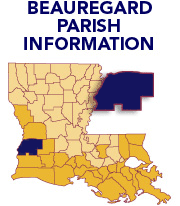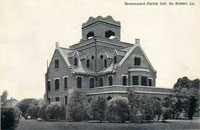 |
| |

Click on a parish to change parishes. |
| |
|
| |
|
| |
|
| |
|
| |
|
| |
PARISH PLANNING BASELINE |
|
|
|
|
| |
|
| |
| |
| |
|
| |
|
| |
 |
|
|
 |
Beauregard Parish
Beauregard Parish, inland from the Gulf Coast and sitting on the eastern border of Texas, celebrates an interesting history as a Western trade outpost. This area of the state grew fast with the introduction of railroads in the mid 1800s and the economy has been fueled by the timber industry for even longer. DeRidder, the parish seat, boasts Victorian-era homes and an antiques district.
At once Southern and Western, Beauregard has an old-time charm and annual festivals associated with both Texas and Louisiana cultures. Excellent fishing and hunting draws many visitors to the western border of Louisiana; Beauregard has often been called a “Sportsman’s Paradise.”
When residents of Beauregard Parish were asked what they valued most about their Parish, they responded:
"We treasure our quiet downtowns and our rural lifestyle. These things changed after the storm.”
|
|

 |
- Beauregard has 1,160 sq. miles in land area and a population density of 29.4 per square mile.
- In the last three decades of the 1900s, its population grew by 44.1%.
- The average household size is 2.63 persons compared to an average family size of 3.07 persons.
- In 2004 retail trade was the largest of 20 major sectors. It had an average wage per job of $19,048.
- Per capita income grew by 7.1% between 1993 and 2003 (adjusted for inflation).
- The parish seat is DeRidder.
- Larger communities are DeRidder, Dry Creek and Merryville.
- The parish was named for Pierre G.T. Beauregard, Confederate General, known for firing “the first shot of the Civil War” at Fort Sumter.
- Pre-storm, the population was 34,000.
- The parish's economy is based on forestry, livestock, paper and clothing manufacturing, and agriculture. The chief crops are soybeans and rice.
|
|
|